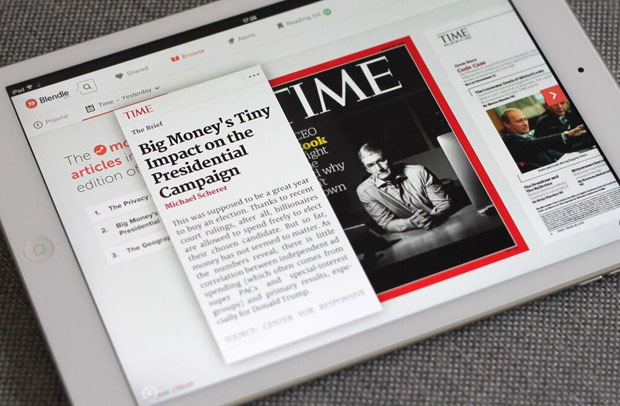Blendle, a Netherlands-based news aggregation site that draws comparisons to Spotify, on Wednesday announced its beta launch in the U.S.
Blendle made its debut with the participation of several major new organizations and financial backing from Axel Springer and The New York Times.
The 5-year-old company, which recently expanded into Germany, has opened the beta phase to 10,000 users who can make refundable micropayments for stories they choose to read.
“Journalism needs a Spotify, a Netflix, an iTunes, whatever you want to call it,” cofounder Alexander Klopping wrote on Medium. “One website that houses the best newspapers and magazines in the country, that allows people to browse through everything and only pay for the stories they like, where you can see what your friends recommended.”
Success in Europe
Since going live in 2014, Blendle has attracted 650,000 registered users who read millions of stories per month in Europe, Klopping noted. Half of the users are under age 35, which is important, because that demographic rarely pays for content.
The site lets users connect their Facebook and Twitter accounts to Blendle, so they can see which stories their friends have shared. Some top journalists, including Felix Salmon, a senior editor atFusion, and Kim Ghattas of the BBC, are on board to select stories on business and politics, respectively.
Generating money from individual users is critical, because digital media outlets are struggling to bring in advertising revenue, Klopping said, with 41 percent of younger readers using ad-blocking plugins on their devices.
Investor Optimism
The companies behind Blendle are optimistic about the potential for the site to be successful in the U.S. Axel Springer and the NY Times invested about US$3.8 million in the site in 2014.
“We at Axel Springer are working on establishing paid content offerings for digital journalism,” spokesperson Michael Schneider told the E-Commerce Times. “That’s why we think that Blendle is so interesting.”
The company established digital paid offerings for Bild, which has 318,000 paid digital subscribers, and Die Welt, which has 78,000 paid digital subscribers, he pointed out. It also launched its own digital newsstand, which other publications can use to distribute electronic versions of their content.
Blendle’s technology and micropayments will not be implemented on any of The New York Times’ sites, a source familiar with the company’s policy told the E-Commerce Times. However, NYT articles will be available on Blendle’s site and via related apps. The Times will work with Blendle to evaluate additional opportunities to integrate the various features as the company grows.
Easy Does It
Micropayments largely have failed in the U.S. until now, but the jury is still out on how successful Blendle will be in growing its U.S. customer base.
Failure of the micropayment model to catch on more widely is “partially due to clumsy, cumbersome payment mechanisms, an issue that could well be addressed by the evolution of digital wallet technologies,” Pund-IT Principal Analyst Charles King told the E-Commerce Times.
Blendle is easy to use and has solved many of the problems that hurt micropayment sites in the past, noted Rick Edmonds, media business analyst for the Poynter Institute. However, the site could suffer from a “look don’t touch” problem as it gains subscribers.
“Even their good results in the Netherlands and Germany suggest that people may register, but not get in the habit of using,” Edmonds told the E-Commerce Times.
That behavior is not uncommon, he suggested, pointing to studies showing that people often download large numbers of apps onto their devices, but only become regular users of four or five of them.
Strong Resistance
Although the benefit for participating media companies includes the ability to generate revenue and attract younger readers, it’s unlikely that the launch will bring radical change to the existing paywall mechanism for at least a couple of years, Edmonds said.
It’s a matter of speculation whether the timing of Blendle’s launch has anything at all to do with The Wall Street Journal’s decision to close the Google paywall loophole last month.
Readers previously had been able to view WSJ stories by clicking on links within Google News, without having to subscribe and pay a fee. Google is a significant provider of referrals to news sites.
U.S. consumers remain very reluctant to pay for content, observed Susan Schreiner, an analyst at C4 Trends, which doesn’t bode well for Blendle.
“Going to a reading app is cumbersome,” she told the E-Commerce Times, “and so is Blendle’s microtransaction model.”























































Social Media
See all Social Media